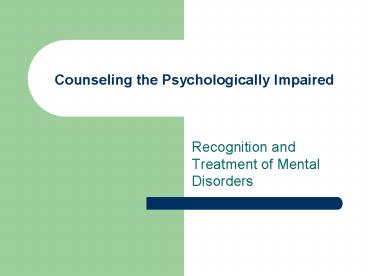Counseling the Psychologically Impaired PowerPoint PPT Presentation
1 / 23
Title: Counseling the Psychologically Impaired
1
Counseling the Psychologically Impaired
- Recognition and Treatment of Mental Disorders
2
(No Transcript)
3
- First recorded depiction of mental illness - 3000
B.C. in Egypt - Senile Dementia - First references to melancholia and hysteria
found as early as 2600 B.C. - Hippocrates (460-377 B.C.) first to place
psychiatric conditions within secular and
naturalistic domain of medicine.
4
(No Transcript)
5
Introduction
- What is a mental disorder
- How do we define and recognize these disorders?
- What different types of disorders exist?
- What causes mental disorders?
6
Epistemology study of the nature of knowledge
- There are balls and there are strikes and I call
them as they are (realism - Middle Ages), - There are balls and there are strikes and I call
them as I see them (middle ground - DSM IV), - There are no balls and there are no strikes until
I call them (nominalism - no reality outside the
mind of the observer)
7
- Medical illnesses are defined on a widely varied
conceptual basis, reflecting our historically
evolving concept of disease. - Mental disorders have also been defined by a
variety of concepts (distress, dyscontrol,
disadvantage, disability, inflexibility,
etiology, statistical deviation)
8
- Before post world war II, the majority of
patients classified were severely ill ind. living
in asylums, there were fewer and more easily
defined categories of mental disorders.
9
- The ever increasing number of new categories
meant to describe the less impaired outpatient
population raises the question of where
psychopathology ends and the wear and tear of
every day life begins.
10
- The DSM I had 106 different diagnostic categories
- The DSM II had 182
- The DSM III listed 265
- The DSM III R included 292
- What is the effect of this increase?
11
Multiple Diagnosis
- 1. The removal of diagnostic exclusion criteria
- 2. The profusion of new categories
- 3. The division of old categories
- 4. The use of structured interviews in clinical
practice
12
Question
- 1. Has psychiatry taken upon itself the task of
pathologizing statistically or morally deviant
individuals? - 2. Could the use of an over-inclusive definition
of mental disorder give the profession a wider
purview of influence and social control than it
can reasonably handle?
13
What is a mental disorder?
- DSM-IV Definition
- A significant behavior that occurs in an
individual that is associated with distress or
disability, or an increased risk for suffering
death, pain, disability, or an important loss of
freedom. This syndrome must not be due to a
culturally sanctioned response.
14
How do we define and identify mental disorders?
- Mental disorders are generally characterized as
abnormal behaviors - Abnormal behaviors can be defined
- Statistically
- Culturally
- Personal Distress
- Maladaptive Behavior
15
- The DSM mental disorders are best understood as
descriptive syndromes likely to assist in our
increased understanding of the underlying
disease, but only in selected cases do they,
actually represent such diseases.
16
Historical Views of Abnormal Behavior
- Evil Spirits
- Exorcism
- Birth of Reason
- Hippocrates- Science
- Reason Lost
- Witch Hunts
- Reason Returns
- Psychology-Wundt
- Psychopathology and DSM (1952, 65, 74, 80, 87-R,
94)
17
(No Transcript)
18
History of the DSM
- DSM I
- 1952
- Myers psychobiological view
- Disorders cause by personality REACTION
- DSM II
- 1968
- Basically the same but references to reaction
were removed
19
History of DSM cont.
- DSM III
- Published in 1980
- Free from theories of etiology
- Initiates use of Multi-axis system
- DSM III-R
- 1987 Revisions made to clarify diagnoses
- DSM IV
- Published 1994
- Categorical
- Cultural and ethnic considerations
- Not based on deviant behaviors
20
DSM IV-TR
- Most current version to date
- Published in 2000
- No changes to diagnoses or criteria
- Changes made to text that was considered
ambiguous - Update of statistical data from new studies.
21
DSM IV-TR Categories
- Diagnoses usually made in infancy, childhood, and
adolescence. - Delirium, Dementia, and Amnesic and other
cognitive disorders. - Mental disorders due to a Medical Condition
- Substance Related Disorders
- Schizophrenia and other psychotic disorders
22
DSM IV-TR Categories Cont.
- Mood Disorders
- Anxiety Disorders
- Somatoform Disorders
- Factitious Disorders
- Dissociate Disorders
- Sexual and Gender Disorders
- Eating Disorders
23
DSM IV-TR Categories
- Sleeping Disorders
- Impulse Control Disorders
- Adjustment Disorders
- Personality Disorder
- Other conditions

